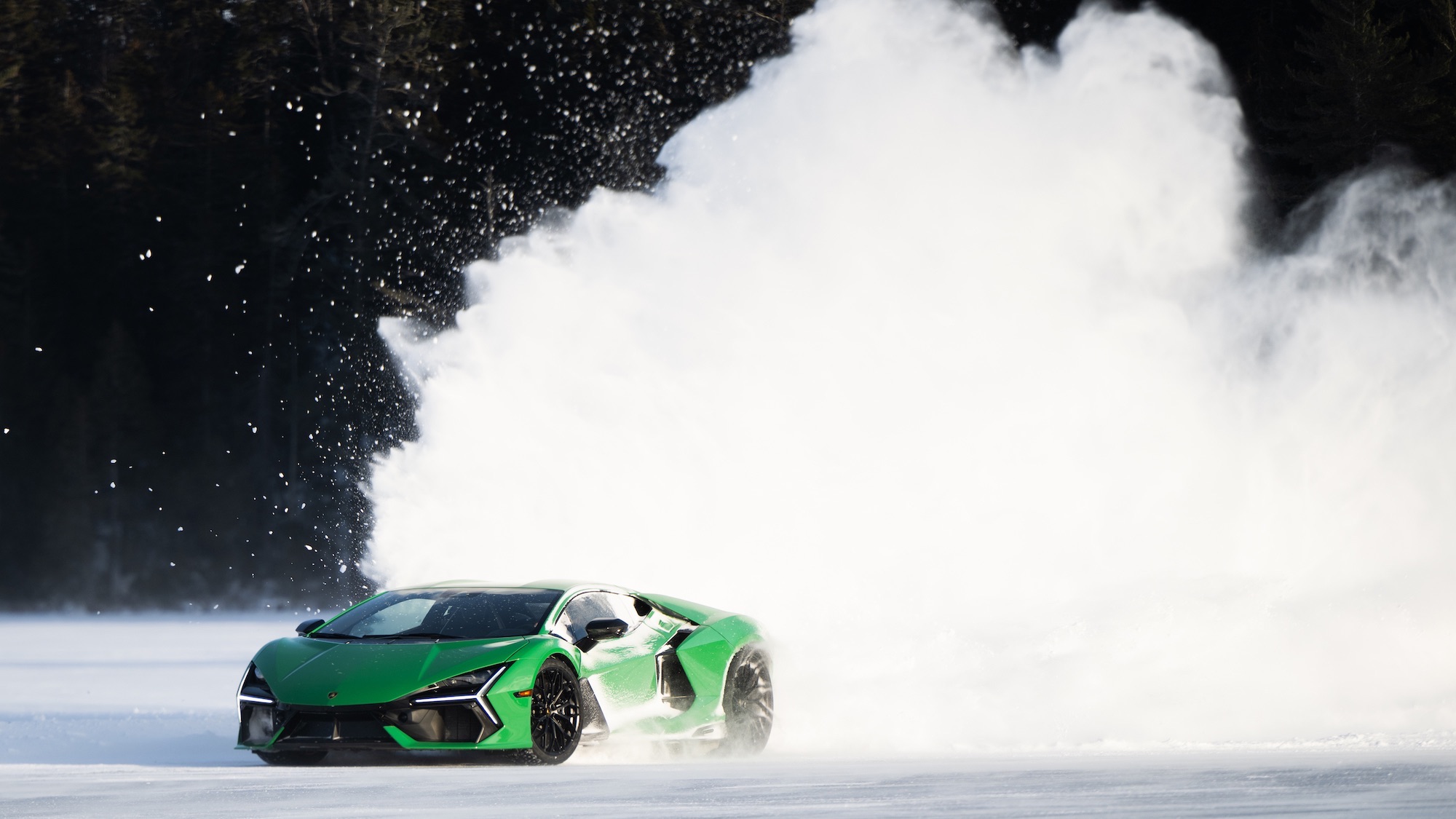Most Lamborghini owners will never drive their supercar on the ice, but they could.
The Astrophysics Data System–a digital library portal for researchers in astronomy and physics–built a complex formula for aircraft landings on ice. There are variables for river ice, lake ice, and even “old sea ice”, which is sea ice that has stayed frozen through at least one melting season. And according to the US Army Corps of Engineers, only 10 inches of ice is needed to hold a seven or eight-ton truck.
That means I felt pretty comfortable next to a fleet of supercars and superSUVs perched atop three solid feet of ice on Lake Sacacomie, north of Montreal. And I was about to find out just how well the metal-studded snow tires would create traction on that frozen lake at ice driving school. Piloting three Lamborghini models—Urus, Huracán Sterrato, and Revuelto—with a professional driver next to me, I learned how it’s possible for these uber-powerful beasts to drift with finesse and without careening out of control. It’s also nice to know that the ice was thick enough to support a 747.
“Like chopping ice in a blender”
Kevin Conway, a multi-time Lamborghini Super Trofeo racing champion, walked me through how to capably drive on an icy figure-eight course. Shod in Pirelli Scorpion winter tires with hundreds of metal studs embedded into the treads, the Urus SE is a quarter-million-dollar sled. New for 2025, the Urus SE is equipped with a plug-in-hybrid powertrain making a total of 789 horsepower from a twin-turbo 4.0-liter V8 gas engine assisted by a 192-hp electric motor. As such, the torque curve is significantly smoothed out for better control.

If you’re not properly applying the throttle, you’re going to slide without control. In the all-wheel-drive SUV, which is shorter and easier to manage than the two supercars, traction is a matter of technique. Still, driving on the ice with that kind of power could be a disaster if not for those metal-bedazzled tires.
“Think about taking chunks of ice and putting it in a blender,” Conway explains from the right seat. “That’s basically what you’re doing with the studs on the tires. The studs shred the ice, and that’s creating two things: you’re putting heat to the tire, which is making the rubber softer, and you’re gaining the traction you need to be able to corner, accelerate, and decelerate.”
Turn off the traction controls?
Even without studs, Bridgestone’s Blizzak winter tires are formidable on snow and ice, employing microscopic bubbles and tiny slits for maximum grip. As I learned last winter at the tire company’s testing ground and snow driving school in Colorado, winter tires include deeper treads and more sipes (small slits in the tire) that bite into the snow. Like a tiny piranha, the “mouths” of the sipes open as tires roll across the surface, pushing snow or water away to improve the grip. The hybrid Revuelto and its roaring 1001-hp V12 hybrid combination typically rolls on Bridgestone Potenza Sports, but for snow school it gets the grippier winter rubber.
Adding 400 studs per tire is no joke; Lamborghini hired a whole team to maintain the tires for each day of driving, and the studs regularly fall out as the day goes on. Re-studding them requires pulling the tires from the wheels, combing over the treads to find missing spikes, and then using a special tool to insert and seal them in a way that doesn’t puncture the tire. Don’t try this at home, folks.
The Revuelto has four main drive modes: Città, Strada, Sport, and Corsa. It sounds counterintuitive, but Corsa is the one I used, which turns off traction control. Typically, traction control is active as a default. However, when a car is stuck in the snow, turning off the traction function slows the spin of your tires; that’s not what you want when you need grip. When driving on ice, disabling both the stability control and traction control override the driver’s intentions, as the slippery surface is completely different than asphalt.

Lever, length, and power curve
The difference between the Revuelto and the Sterrato goes beyond the drivetrain, which is still powerful in the latter at 602 horsepower and 413 lb-ft of torque. The Huracán variant was made to tear across the desert at high speed in the dirt and sand, while the Revuelto is a street-and-track star. The Sterrato is rear-wheel drive to the Revuelto’s all-wheel drive, and the Sterrato is shorter and skinnier across. Each has a distinct personality and each works differently on the ice and the road.
“Driving the Sterrato is like choking up on the sledgehammer,” lead driver Dean diGiacomo. “You’ve got to use more effort to swing it to transfer the weight. Driving the Revuelto is like holding the end of the sledgehammer, where it takes more effort to get the weight transfer started, but once it starts, it’s gonna keep going.”
I can feel it on the curvy ice roads as the weight shifts from side to side. Once a slide is in progress, the best thing to do is continue giving power even though your brain wants to tell you to take your foot off the gas. That’s actually the worst thing you can do, diGiacomo says, because one of two things will happen: you’ll either lose the slide because it wasn’t initialized enough to begin with, or it will keep rotating around. Applying power allows the front wheels to pull it out of the slide.
But I mean, let’s be honest: Who drives a roughly-$700,000 supercar on the ice? That would be crazy. Unless you turn off the electronic stability control, fit it with the right tires, and have a pro telling you exactly when to turn, when to step on the gas, and when to coast (carefully).


